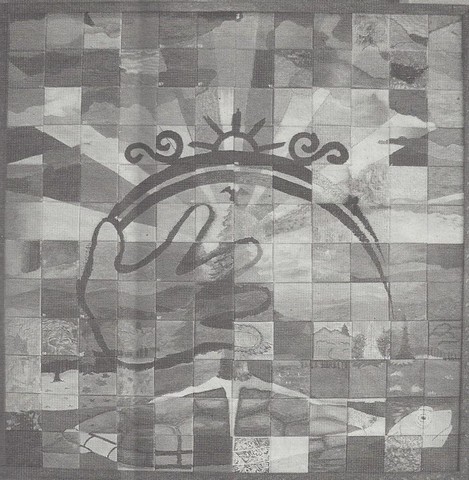Onkwéhon:we Art council - Akwesasne
Article by Samantha McMillon-Wilkinson
Indian Time Vol 31# 13
April 3, 2014
The Onkwéhon:we Arts Council Mosaic «The Fabric of Our Culture» can be seen in the lobby of Kanonhkwatsheriio.
If you haven't seen the Mosaic that the Onkwéhon:we Arts Council, with the help of many community members, put together, then you should stop in to the Kanonhkwatsheriio lobby. Better yet, if you have seen the mosaic, you should stop in to see how many tiles you never noticed before, because the more you look at it, the more you see. Even Charlotte King, who has seen the mosaic more than most, noticed something new just the other day. If you didn't know, besides beautiful acrylic paint, some tiles have beads, buttons, fabric, copper, watercolor, ribbon, yarn, sparkles and stones. And that's probably not all. The lobby is an excellent place to view
the mosaic as you usually have it all to yourself .
Many people have been gathering, socializing and admiring the piece. It is pulling a lot of interest and there are certainly enough artists in the community to create another. Some said they now wish they would have been involved in the project, and hope for another opportunity to get involved. And you may be in luck. Council member Charlotte King hopes to do another mosaic in the fall, and this time there will be more freedom for the artists. If you are an artist you should definitely consider joining the Onkwéhon:we Arts Council. They have a lot to offer artists and they would love to plan art shows and festivals if more artists would be involved. For information, and if you are interested in displaying the Mosaic, you can find them on Facebook at Onkwéhon:we Arts Council.
Onkwéhon:we Arts Council Mosaic Project - "The Fabric of Our Culture"
By Charlotte King
The Mosaic Project is a six feet by six feet picture made up of 144 six inch by six inch canvases arranged together to form a larger picture. The mosaic was an idea from the Onkwéhon:we Arts Council to include the community in a large-scale project to bring awareness of the OAC and to promote the arts in Akwesasne. The canvases were divided between the community of Akwesasne, Massena Central High School, Salmon River Central School and C.C.V.S. in Cornwall. The Mosaic was revealed at an event on December 15 at the St. Regis Recreation Center.
The Project
Each artist received pre-numbered 6x6 inch canvas . These canvases had sections that tie into the larger design. Artists were encouraged to use whatever medium they wanted to complete their canvas. They could use coloured pencils, paint, computer print out, fabric, etc.
Inspiration for the Design
We wanted to create an art piece that most people in the community of Akwesasne could participate and identify with. What we decided on was the Tree of Peace on the back of the great Turtle Island (earth). The Tree of Peace comes from Iroquois culture and it represents the gathering place for all the nations to meet in peace. The weapons were buried under the tree and the white roots from the tree are called the White Roots of Peace that spread out in all directions Turtle Island. If any nation wishes for peace they can follow the roots back the Tree of Peace.
We thank all the artists, students of art and the community at large for their encouragement and support in the project. we Arts Council sent
Arts Council Logo
The hand, the arches, and the sun is the of the Onkwéhon:we Arts Council. The hand represents the ability to create. It was inspired by pre-history paintings. The outline of the hand was a nod to our ancient culture and technique of using positive/negative space by "spraying" pigment over the hand and lifting the hand to reveal outline. This was an act of creating. The dome and swirls en the logo represent design elements of Iroquoian culture. The arches represent the sky world or sky dome, and our connection with
creation. The swirls are celestial trees that represent the inspiration we receive
and the communication we have with the sky world. The sun represents the
impact that art has on people who view beauty and allow it into their lives.
We thank all the artists, students of art and the community at large for their encouragement and support in the project.
Onkwéhon:ne Arts Council
- Californium
- Diamond
- Gold
- Silver
